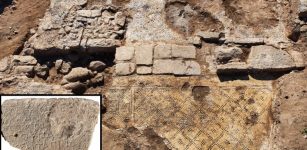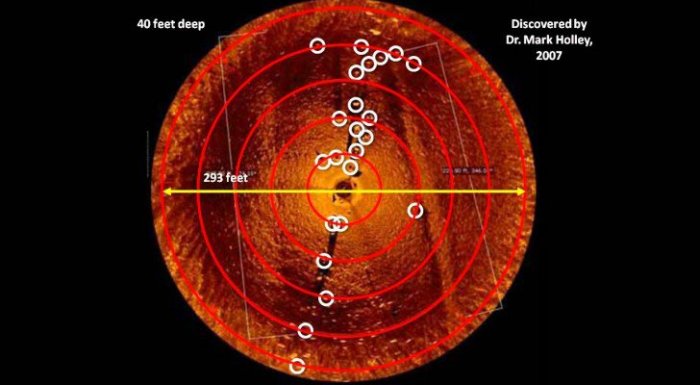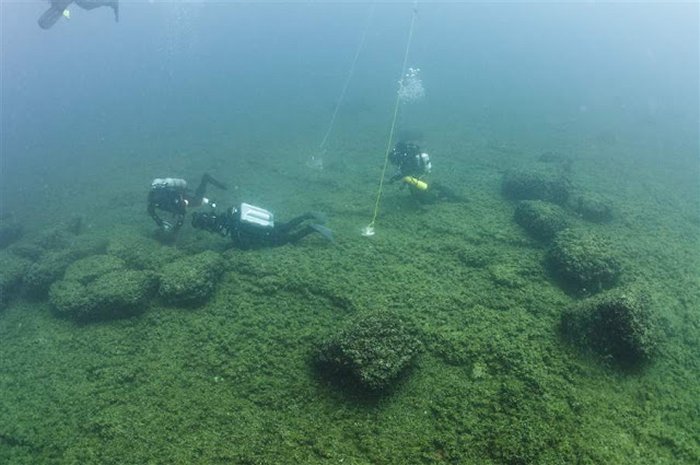Is The Intriguing Underwater Structure Beneath Lake Michigan Man-Made Or A Natural Formation?
Jan Bartek - AncientPages.com - Ancient underwater ruins are as important and intriguing as anything prehistoric we discovered on the surface of the Earth. There are still many unexplored, submerged ancient villages, whole cities, massive monuments, and artifacts that, if properly examined, could help us answer many questions about humans' distant past.
Often built by lost or forgotten civilizations, these ancient structures are memories of long-gone times.
Sonar image of the stones beneath the Waters of Lake Michigan. Credit: Dr. Mark Holley
Sometimes, scientists encounter mysterious ancient underwater structures that, unfortunately, sooner or later become forgotten.
Such is the case with an odd structure discovered beneath Lake Michigan in the United States.
Dr. Mark Holley from the University of Michigan is a trained operational/scientific diver who has years of "experience in the survey of underwater prehistoric sites and has been principal investigator for several surveys of underwater sites in Scotland, Ireland, Greece, and the United States." 1
One of Dr. Holley's most puzzling underwater discoveries occurred when he was searching for shipwrecks in Lake Michigan, and instead, he stumbled upon something totally unexpected.
Grand Traverse Bay, the northeastern arm of Lake Michigan, is famous for underwater shipwreck dive sites often visited by underwater archaeologists and adventure-seeking tourists.
About 40 feet beneath Lake Michigan's glowing waters, Dr. Holley discovered stones arranged in a long line, over one mile in length.
According to some sensational news stories, one of the boulders, about three and a half to four feet high and five feet wide, had a mastodon carving on it! How was it possible when the animal had been extinct for about 11,00 years?
There is no scientific evidence the rock has a mastodon carving. These are merely scientifically unsupported assumptions.
Dr. Holley shows the rock with what some interpret as a mastodon carving. No scientist has yet confirmed this is a rock carving of the long-extinct animal. Credit: Dr. Holley
Lake Michigan's prehistoric site reminds of a smaller version of Stonehenge in the U.K. The "rocks found under Grand Traverse Bay range in size from a basketball to a compact car.
Dating on the stones traces back to around 9,000 years ago. That is 4,000 years before Stonehenge was built and around two thousand years after the Ice Age ended. It was at a time when the lake bed was dry and before Grand Traverse Bay existed." 2
Everything indicated the submerged stones had been arranged intentionally. The curious submerged formation is often called Lake Michingan's Stonehenge, but no researchers have called it a "Stonehenge."
"This site seems to gain a life in the media about every six months or so. Sadly, much of the information out there is incorrect. For example, there is not a henge associated with the site and the individual stones are relatively small when compared to what most people think of as European standing stones.
Credit: Dr. Holley
It should be clearly understood that this is not a megalith site like Stonehenge. This label has been placed on the site by individuals in the press who may have been attempting to generate sensation about the story and have not visited the site. The site in Grand Traverse Bay is best described as a long line of stones which is over a mile in length," Dr. Holley said.1
The underwater formation in Lake Michigan. Credit: Dr. Holley
The precise location of the Lake Michigan "Stonehenge-like" structure remains shrouded in secrecy. "Upon his discovery, Dr. Holley extended the courtesy of informing the Grand Traverse Band of Ottawa and Chippewa tribes—a gesture of respect toward their ancestral heritage and a safeguard against accidental destruction of the site. As a result, the exact coordinates of this archaeological marvel are withheld from the public domain. 3
Who raised the puzzling underwater structure, and for what purpose? Is it made or a natural formation? Had Dr. Helley found evidence of an unknown 9,000-year-old civilization that once lived around Lake Michigan?
Lake Michigan's underwater "Stonehenge" was discovered in 2007. Still, little news about the site has emerged recently.
It is, however, not the only strange prehistoric submerged site in this region.
As AncientPages.com reported in 2014, while exploring Lake Huron, one of the five Great Lakes of North America, underwater archaeologists found traces of an ancient lost civilization twice as old as Stonehenge and the Great Pyramids of Egypt.
Scientists were thrilled when U.S. radar suddenly detected an odd structure at the bottom of Lake Huron. This was the first puzzle piece that led to a 9,000-year-old discovery.
Dr. John O'Shea from the University of Michigan noticed the peculiarity and, through a leap of innovative thinking, concluded that the structure was perfect for caribou hunting corridors. He then assembled a team to explore the ridge and what he found was groundbreaking.
As reported, underwater archaeologists have seemingly found what was once a dry land corridor connecting northeast Michigan and southern Ontario. Scientists say the main feature, dubbed the Drop 45 Drive Lane, is the most complex hunting structure found beneath the Great Lakes to date. The 9,000-year-old limestone structure comprises two parallel lines of stones leading to a cul-de-sac lined with natural cobble. If the findings are correct, it would make the hunting complex twice as old as Stonehenge.” 4
In 2022, “underwater archaeologists from the University of Texas at Arlington have confirmed the 9,000-year-old stone tool artifacts discovered in Lake Huron originated from an obsidian quarry more than 2,000 miles away in central Oregon.
There is still much to learn about Lake Huron's ancient structures. Credit: Tane Casserley
The obsidian flakes from the underwater archaeological site represent the oldest and farthest east confirmed specimens of western obsidian ever found in the continental United States.” 5
If we add to this the discovery of strange circle boulders on Beaver Island, the story becomes even more fascinating. Beaver Island is the largest island in Lake Michigan.
1985 a circular stone arrangement was found on the island's western side. When the site was examined, Native American elders from the surrounding areas recalled stories of a stone calendar on Beaver Island, near Peshawbestown, a historic Native American village. At this place, there is a large stone with unknown markings in the center of the site, with other rocks seemingly arranged around it.
“The stones and boulder arranged around it also have carvings, which appear to be sheaths of feathers. While no carbon dating or other analytical studies have been done on the site, it is mostly accepted that the site had a high significance and was used as an important, ceremonial site for Native Americans who once inhabited Beaver Island.” 6
The discoveries mentioned above could easily open a new chapter in the ancient history of North America. Unfortunately, the archaeological finds have been neglected and even forgotten.
Without further research and analysis, it is impossible to determine whether these underwater structures are the work of Mother Nature or an ancient unknown civilization.
Written by Jan Bartek - AncientPages.com Staff Writer
Updated on June 24, 2024
Copyright © AncientPages.com All rights reserved. This material may not be published, broadcast, rewritten or redistributed in whole or part without the express written permission of AncientPages.com
Expand for referencesMore From Ancient Pages
-
 Mysterious Underwater Ruins In Canada And America – Evidence Of An Unknown Ancient Civilization?
Civilizations | Sep 17, 2020
Mysterious Underwater Ruins In Canada And America – Evidence Of An Unknown Ancient Civilization?
Civilizations | Sep 17, 2020 -
 Oldest Lunar Calendar Engraved On A Pebble Dated To 10,000 Years Ago
Archaeology | Aug 5, 2019
Oldest Lunar Calendar Engraved On A Pebble Dated To 10,000 Years Ago
Archaeology | Aug 5, 2019 -
 On This Day In History: Battle of Salamis Was Fought – On Sep 22, 480 BC
News | Sep 22, 2016
On This Day In History: Battle of Salamis Was Fought – On Sep 22, 480 BC
News | Sep 22, 2016 -
 John Hawkwood ‘John Sharp’: Feared, English Mercenary And His White Company In 14th Century Italy
Featured Stories | Jun 20, 2020
John Hawkwood ‘John Sharp’: Feared, English Mercenary And His White Company In 14th Century Italy
Featured Stories | Jun 20, 2020 -
 Viking Children Were Buried With Extremely Sharp Knives – Afterlife Tools To Be Used In Valhalla?
Ancient History Facts | Nov 29, 2017
Viking Children Were Buried With Extremely Sharp Knives – Afterlife Tools To Be Used In Valhalla?
Ancient History Facts | Nov 29, 2017 -
 Miniature Magical Stela Of God Horus-Child Standing On Crocodiles Protected Against Wild And Poisonous Creatures
Artifacts | Aug 16, 2019
Miniature Magical Stela Of God Horus-Child Standing On Crocodiles Protected Against Wild And Poisonous Creatures
Artifacts | Aug 16, 2019 -
 1,500-Year-Old Inscription ‘Christ, Born Of Mary’ Engraved On Magnificent Building Discovered In Israel
Archaeology | Jan 21, 2021
1,500-Year-Old Inscription ‘Christ, Born Of Mary’ Engraved On Magnificent Building Discovered In Israel
Archaeology | Jan 21, 2021 -
 Gods’ Creation Of Five Different Human Races – Ages Of Man On The Earth And The End Of The World
Featured Stories | Jan 26, 2018
Gods’ Creation Of Five Different Human Races – Ages Of Man On The Earth And The End Of The World
Featured Stories | Jan 26, 2018 -
 First People To Inhabit Malta Arrived 700 Years Earlier Than Previously Thought
Archaeology | Mar 20, 2018
First People To Inhabit Malta Arrived 700 Years Earlier Than Previously Thought
Archaeology | Mar 20, 2018 -
 Mystery Of The Langeid Viking Sword And Its Undeciphered ‘Magical’ Inscriptions
Artifacts | Jun 4, 2022
Mystery Of The Langeid Viking Sword And Its Undeciphered ‘Magical’ Inscriptions
Artifacts | Jun 4, 2022 -
 Arachne – Spider Woman Who Challenged Goddess Athena And Was Punished
Featured Stories | Dec 5, 2018
Arachne – Spider Woman Who Challenged Goddess Athena And Was Punished
Featured Stories | Dec 5, 2018 -
 On This Day In History: Sir Thomas Brisbane, Astronomer, Soldier And Governor Was Born – On July 23, 1773
News | Jul 23, 2016
On This Day In History: Sir Thomas Brisbane, Astronomer, Soldier And Governor Was Born – On July 23, 1773
News | Jul 23, 2016 -
 1,200-Year-Old Rock-Cut Temple Found On Banks Of Arjuna River,Tamil Nadu, India
Archaeology | Sep 3, 2020
1,200-Year-Old Rock-Cut Temple Found On Banks Of Arjuna River,Tamil Nadu, India
Archaeology | Sep 3, 2020 -
 Ancient Sound Of Stones – Acoustics At Stonehenge Tested By Scientists
Ancient Technology | Aug 29, 2020
Ancient Sound Of Stones – Acoustics At Stonehenge Tested By Scientists
Ancient Technology | Aug 29, 2020 -
 7,000-Year-Old Kilns From Ceramics Workshop Unearthed In Northeast Bulgaria
Archaeology | Nov 20, 2020
7,000-Year-Old Kilns From Ceramics Workshop Unearthed In Northeast Bulgaria
Archaeology | Nov 20, 2020 -
 Belobog White God In Everlasting Fight With His Cursed, Evil Counterpart, Chernobog In Slavic Beliefs
Featured Stories | Dec 4, 2017
Belobog White God In Everlasting Fight With His Cursed, Evil Counterpart, Chernobog In Slavic Beliefs
Featured Stories | Dec 4, 2017 -
 Homo Bodoensis Is A New Species Of Human Ancestors Who Lived Half A Million Years Ago
Archaeology | Nov 1, 2021
Homo Bodoensis Is A New Species Of Human Ancestors Who Lived Half A Million Years Ago
Archaeology | Nov 1, 2021 -
 Can Baboons Solve The Ancient Mystery Of Punt?
Archaeology | Oct 25, 2023
Can Baboons Solve The Ancient Mystery Of Punt?
Archaeology | Oct 25, 2023 -
 Can You Solve The Mystery Of The Nessglyph? Archaeologists Ask
Archaeology | Jan 31, 2023
Can You Solve The Mystery Of The Nessglyph? Archaeologists Ask
Archaeology | Jan 31, 2023 -
 3,000-year-old knight discovered at the Palidli necropolis
Civilizations | Aug 22, 2015
3,000-year-old knight discovered at the Palidli necropolis
Civilizations | Aug 22, 2015





